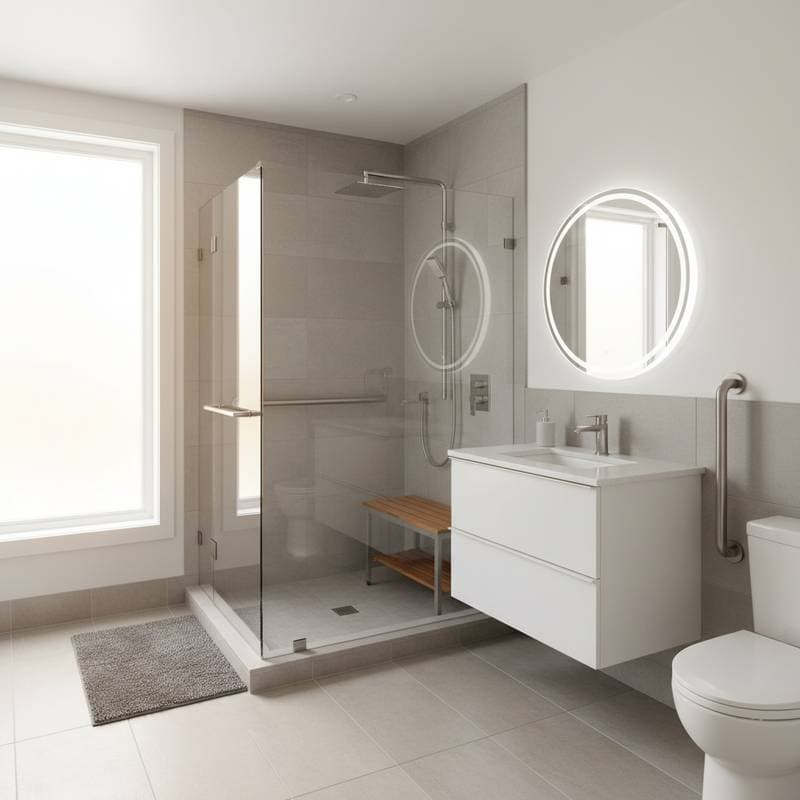Introduction to Accessible Bathroom Upgrades
Accessible bathroom upgrades enhance safety and usability for individuals with mobility challenges, aging in place, or temporary needs. In 2025, these modifications balance functionality with modern aesthetics, ensuring spaces remain inviting. Costs vary widely based on scope, from minor additions to complete overhauls, but each investment promotes independence and reduces risks like slips or strains.
Planning begins with assessing current layouts and user requirements. Professional consultations help identify priorities, such as grab bars or zero-threshold entries. This guide outlines typical 2025 expenses, drawing on industry trends for materials and labor, to provide clear expectations.
Core Safety Features and Their Costs
Grab bars offer essential support near toilets, showers, and tubs. Installation costs range from $200 to $600 per bar, including reinforced mounting to handle up to 250 pounds. Opt for ADA-compliant models in brushed nickel or stainless steel for durability and style.
Slip-resistant flooring prevents accidents on wet surfaces. Replacing standard tiles with textured porcelain or vinyl costs $5 to $15 per square foot, plus $1,000 to $3,000 in labor for a typical 50-square-foot bathroom. These materials maintain grip even when wet, combining safety with easy maintenance.
Lever-style faucets and touchless fixtures simplify operation for those with limited dexterity. Basic lever handles add $100 to $300, while sensor faucets range from $400 to $800 installed. Such upgrades reduce strain and align with universal design principles.
Shower and Tub Transformations
Curbless or roll-in showers eliminate barriers for wheelchair access. Conversion from a traditional setup costs $5,000 to $15,000, covering waterproofing, drainage, and tiling. In 2025, integrated linear drains and Schluter systems streamline installation, minimizing leaks.
Shower benches or seats provide resting spots during bathing. Fold-down models cost $300 to $700, with built-in options adding $1,000 to $2,500 in a custom shower. Pair these with handheld showerheads on sliding rails, priced at $150 to $400, for adjustable height and reach.
Tub-to-shower conversions suit those preferring baths occasionally. Expect $4,000 to $12,000, including removal and new enclosures. Walk-in tubs with built-in seats and jets range higher, from $8,000 to $20,000, offering therapeutic benefits alongside accessibility.
Toilet and Vanity Modifications
Raised or comfort-height toilets ease standing and sitting. Replacement costs $400 to $1,200, including wall-mounted bidets at $500 to $1,500 for added hygiene. These fixtures support up to 300 pounds and integrate seamlessly with existing plumbing.
Wall-mounted vanities free up floor space for maneuvering. Installation runs $1,000 to $3,500, depending on size and stone countertops. Adjustable-height models, starting at $2,000, accommodate varying user needs over time.
Bidet attachments or standalone units enhance cleanliness without paper. Basic seat attachments cost $100 to $400, while full electronic systems reach $1,000 to $2,500. They feature warm water, air drying, and remote controls for effortless use.
Flooring, Lighting, and Comfort Enhancements
Heated floors add warmth underfoot, especially beneficial in cooler climates. Electric mat systems cost $1,000 to $2,500 for a standard bathroom, with hydronic options up to $4,000. These integrate beneath tiles, programmable via apps for energy efficiency.
Layered lighting improves visibility and reduces shadows. Recessed LEDs cost $200 to $600 per fixture, while vanity strips add $150 to $400. Dimmable options and motion sensors, at $50 to $200 each, support low-vision users and nighttime navigation.
Anti-fog mirrors with integrated lighting cost $300 to $800. They expand perceived space and assist with grooming tasks, often including magnification for precision.
7. Doorways and Layout Adjustments
Widening doorways accommodates wheelchairs or walkers, typically to 32 inches minimum. Costs range from $800 to $2,500, varying by wall construction like load-bearing versus partition. This involves framing adjustments and new hardware.
Pocket or barn doors save space by sliding along walls. Installed prices start at $900, reaching $2,000 for custom wood or glass panels. They eliminate swing paths, improving flow in tight quarters.
Layout shifts, such as repositioning fixtures, add $2,000 to $5,000 due to plumbing rerouting. These ensure at least 30-inch clearances around key areas, enhancing overall navigation.
Factors Influencing Total Costs
Material selections drive expenses: luxury quartz versus laminate countertops differ by $50 to $200 per square foot. Labor rates, averaging $50 to $100 hourly in 2025, rise in urban areas or for complex permits.
Bathroom size matters; a powder room upgrade costs less than a master suite. Existing conditions, like outdated wiring, can add $1,000 to $3,000 for updates. Energy-efficient features qualify for rebates, offsetting 10 to 20 percent of costs.
Hiring certified contractors ensures compliance with building codes. Full remodels, including demolition and waterproofing, total $15,000 to $35,000, while targeted updates stay under $5,000.
Broader Lifestyle Advantages
These upgrades extend beyond safety to daily convenience. Curbless showers simplify cleaning with seamless surfaces. Wall-mounted fixtures foster an open feel, ideal for families or guests.
Thoughtful lighting calms routines, from dawn preparations to evening unwinds. Real estate values increase by 5 to 10 percent with accessible features, appealing to multigenerational buyers seeking longevity.
Everyone benefits: caregivers assist more easily, children play safely, and visitors navigate without hesitation. The result is a versatile space that adapts to life's phases.
Sustaining Your Upgrades
Post-installation, routine care preserves functionality. Clean tiles with pH-neutral solutions to retain slip resistance. Inspect grab bars and benches yearly, tightening mounts as needed.
Monitor seals around showers and tubs to prevent water damage. Replace caulk every two years and test heated floors for even warmth. Adjustable elements, like extendable shower wands, allow ongoing personalization.
Motion lights and sensors require battery checks biannually. These habits extend the lifespan of investments, maintaining a reliable sanctuary.
Steps to Launch Your Project
Start by evaluating needs through a home assessment. Set a budget allocating 40 percent to materials and 60 percent to labor. Consult local experts for quotes, prioritizing those experienced in aging-in-place designs.
Select timeless finishes that blend accessibility with style. Track progress with detailed timelines to minimize disruptions. The outcome delivers not just a bathroom, but enduring independence and serenity.

